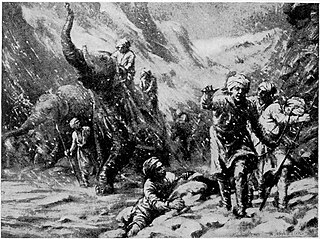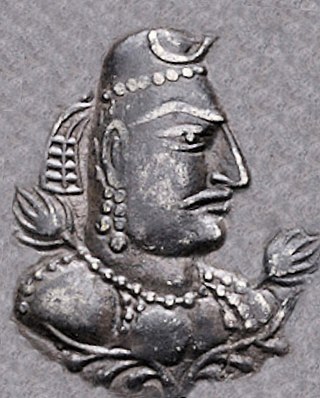Related Research Articles

The history of preceding the country's independence in 1947 is shared with that of Afghanistan, India, and Iran. Spanning the western expanse of the Indian subcontinent and the eastern borderlands of the Iranian plateau, the region of present-day Pakistan served both as the fertile ground of a major civilization and as the gateway of South Asia to Central Asia and the Near East.

Kumyks are a Turkic people, indigenous to Dagestan, Chechnya and North Ossetia. They are the largest Turkic people in the North Caucasus.

Gandhāra was an ancient region located in the present-day north-west Pakistan and parts of south-east Afghanistan. The region centered around the Peshawar valley and Swat valley, though the cultural influence of "Greater Gandhara" extended across the Indus river to the Taxila region in Potohar Plateau and westwards into the Kabul valley in Afghanistan, and northwards up to the Karakoram range.

Yamīn-ud-Dawla Abul-Qāṣim Maḥmūd ibn Sebüktegīn, usually known as Mahmud of Ghazni or Mahmud Ghaznavi, was the founder of the Turkic Ghaznavid dynasty, ruling from 998 to 1030. At the time of his death, his kingdom had been transformed into an extensive military empire, which extended from northwestern Iran proper to the Punjab in the Indian subcontinent, Khwarazm in Transoxiana, and Makran.

Greater India, or the Indian cultural sphere, is an area composed of many countries and regions in South and Southeast Asia that were historically influenced by Indian culture, which itself formed from the various distinct indigenous cultures of these regions. Specifically Southeast Asian influence on early India had lasting impacts on the formation of Hinduism and Indian mythology. Hinduism itself formed from various distinct folk religions, which merged during the Vedic period and following periods. The term Greater India as a reference to the Indian cultural sphere was popularised by a network of Bengali scholars in the 1920s. It is an umbrella term encompassing the Indian subcontinent, and surrounding countries which are culturally linked through a diverse cultural cline. These countries have been transformed to varying degrees by the acceptance and induction of cultural and institutional elements from each other. Since around 500 BCE, Asia's expanding land and maritime trade had resulted in prolonged socio-economic and cultural stimulation and diffusion of Hindu and Buddhist beliefs into the region's cosmology, in particular in Southeast Asia and Sri Lanka. In Central Asia, transmission of ideas were predominantly of a religious nature. The spread of Islam significantly altered the course of the history of Greater India.

Jayapala or Jaipal was a ruler of the Hindu Shahi dynasty from 964 to 1001 CE.

Zabulistan, was a historical region in southern Afghanistan roughly corresponding to the modern provinces of Zabul and Ghazni. Following the Ghaznavid rule (977–1186), "Zabul" became largely synonymous with the name of its capital and main city, Ghazni.

Hinduism in Afghanistan is practiced by a tiny minority of Afghans, believed to be about 30-40 individuals as of 2021, who live mostly in the cities of Kabul and Jalalabad. Afghan Hindus are ethnically Pashtun, Hindkowan (Hindki), Punjabi, or Sindhi and primarily speak Pashto, Hindko, Punjabi, Dari, and Hindustani (Urdu-Hindi).
Pakhli Sultanate was an ancient sarkar (district) of the Mughal Subah of Punjab, now part of Hazara, Pakistan. It roughly corresponds to the ancient Urasa, the Aρσa or Οΰaρσa, which Ptolemy placed between the Bidaspes and the Indus River. It was part of the Gandhara or Gandharva country of antiquity. It later became part of Chandragupta Maurya's empire. The archaeological remains found here suggest that this was a place of great Buddhist learning. In the Rajatarangini this place appeared as a separate kingdom and then again as tributary to the Kashmir valley. The Ain-i-Akbari refers to this entire region as Sarkar Pakhli, which formed a part of the larger Kashmir province, which in turn was part of Subah Kabul. The area of Pakhli today forms a part of the Mansehra of the Khyber-Pakhtunkhwa province of Pakistan.

The Archi people are an ethnic group who live in eight villages in Southern Dagestan, Russia. Archib is the 'parent village' of these, because three months a year the whole community used to reassemble in Archi to engage in communal work. Their culture is one of the most distinct and best-preserved of all the cultures of Dagestan.
Zunbil, also written as Zhunbil, or Rutbils of Zabulistan, was a royal dynasty south of the Hindu Kush in present southern Afghanistan region. They ruled from circa 680 AD until the Saffarid conquest in 870 AD. The Zunbil dynasty was founded by Rutbil, the elder brother of the Turk Shahi ruler, who ruled over a Khalaj -Hephthalite kingdom from his capital in Kabul. The Zunbils are described as having Turkish troops in their service by Arabic sources like Tarikh al-Tabari and Tarikh-i Sistan.

The Hindu Shahis were a dynasty that held sway over the Kabul Valley, Gandhara and western Punjab during the early medieval period in the Indian subcontinent. Details regarding past rulers can only be assembled from disparate chronicles, coins and stone inscriptions.
The Lodi dynasty was the last dynasty to rule over Emirate of Multan, from their capital city of Multan in the 10th century.

Johann von Michelsohnen was a Baltic-German military commander who served in the Imperial Russian Army. He was a prominent general in several wars, but his most noted contribution was his critical role in suppressing Pugachev's Rebellion.
Narodnaya Shkola was a pedagogical fortnightly published in Saint Petersburg in 1869–1889. The journal's objective was providing the teachers, mostly in the Russian province, with the new methodological and theoretical materials, as well as keeping a general view on the state of school education in Imperial Russia. The magazine was edited first by Fyodor Mednikov (1869—1877), then by Vasily Yevtushevski and Alexander Pyatkovsky (1878—1882), then by Pyatkovsky alone. The best Russian practicing pedagogues and theoreticians contributed to Narodnaya Shkola, including Fyodor Rezener, Vasily Vodovozov, Vladimir von Boole, Nikolai Bunakov and Dmitry Semyonov.

The Alchon Huns, also known as the Alchono, Alxon, Alkhon, Alkhan, Alakhana and Walxon, were a nomadic people who established states in Central Asia and South Asia during the 4th and 6th centuries CE. They were first mentioned as being located in Paropamisus, and later expanded south-east, into the Punjab and central India, as far as Eran and Kausambi. The Alchon invasion of the Indian subcontinent eradicated the Kidarite Huns who had preceded them by about a century, and contributed to the fall of the Gupta Empire, in a sense bringing an end to Classical India.

The Turk Shahis or Kabul Shahis were a dynasty of Western Turk, or mixed Turko-Hephthalite, origin, that ruled from Kabul and Kapisa to Gandhara in the 7th to 9th centuries AD. They may have been of Khalaj ethnicity. The Gandhara territory may have been bordering the Kashmir kingdom and the Kanauj kingdom to the east. From the 560s, the Western Turks had gradually expanded southeasterward from Transoxonia, and occupied Bactria and the Hindu-Kush region, forming largely independent polities. The Turk Shahis may have been a political extension of the neighbouring Western Turk Yabghus of Tokharistan. In the Hindu-Kush region, they replaced the Nezak Huns – the last dynasty of Bactrian rulers with origins among the Xwn (Xionite) and/or Huna peoples.
Sergey Pavlovich Nikitsky was a Russian theologian, writer, translator.
Kisten Ridge — one of the mountain ranges of the Greater Caucasus, located in the northeastern part of it, along the left bank of the Andy Koisu River. It forms the watershed of the basin of this river with the rivers of the Sunzha River basin. From the slopes of the river flow Aksay, Aktash.
The Tokhara Yabghus or Yabghus of Tokharistan were a dynasty of Western Turk–Hephtalite sub-kings with the title "Yabghus", who ruled from 625 CE in the area of Tokharistan north and south of the Oxus River, with some smaller remnants surviving in the area of Badakhshan until 758 CE. Their legacy extended to the southeast where it came into contact with the Turk Shahis and the Zunbils until the 9th century CE.
References
- ↑ Босворт, Клиффорд Эдмунд. Мусульманские династии. Справочник по хронологии и генеалогии. — Москва: Главная редакция восточной литературы издательства «Наука», 1971. — С. 255.
- ↑ Encyclopedic dictionary of Brockhaus and Efron: in 86 tons (82 tons and 4 extra). - SPb., 1890-1907; See: India, XIII, 139.